Alessio Burrello
Lightweight Software Kernels and Hardware Extensions for Efficient Sparse Deep Neural Networks on Microcontrollers
Mar 08, 2025Abstract:The acceleration of pruned Deep Neural Networks (DNNs) on edge devices such as Microcontrollers (MCUs) is a challenging task, given the tight area- and power-constraints of these devices. In this work, we propose a three-fold contribution to address this problem. First, we design a set of optimized software kernels for N:M pruned layers, targeting ultra-low-power, multicore RISC-V MCUs, which are up to 2.1x and 3.4x faster than their dense counterparts at 1:8 and 1:16 sparsity, respectively. Then, we implement a lightweight Instruction-Set Architecture (ISA) extension to accelerate the indirect load and non-zero indices decompression operations required by our kernels, obtaining up to 1.9x extra speedup, at the cost of a 5% area overhead. Lastly, we extend an open-source DNN compiler to utilize our sparse kernels for complete networks, showing speedups of 3.21x and 1.81x on a ResNet18 and a Vision Transformer (ViT), with less than 1.5% accuracy drop compared to a dense baseline.
Coupling Neural Networks and Physics Equations For Li-Ion Battery State-of-Charge Prediction
Dec 21, 2024



Abstract:Estimating the evolution of the battery's State of Charge (SoC) in response to its usage is critical for implementing effective power management policies and for ultimately improving the system's lifetime. Most existing estimation methods are either physics-based digital twins of the battery or data-driven models such as Neural Networks (NNs). In this work, we propose two new contributions in this domain. First, we introduce a novel NN architecture formed by two cascaded branches: one to predict the current SoC based on sensor readings, and one to estimate the SoC at a future time as a function of the load behavior. Second, we integrate battery dynamics equations into the training of our NN, merging the physics-based and data-driven approaches, to improve the models' generalization over variable prediction horizons. We validate our approach on two publicly accessible datasets, showing that our Physics-Informed Neural Networks (PINNs) outperform purely data-driven ones while also obtaining superior prediction accuracy with a smaller architecture with respect to the state-of-the-art.
EnhancePPG: Improving PPG-based Heart Rate Estimation with Self-Supervision and Augmentation
Dec 20, 2024



Abstract:Heart rate (HR) estimation from photoplethysmography (PPG) signals is a key feature of modern wearable devices for health and wellness monitoring. While deep learning models show promise, their performance relies on the availability of large datasets. We present EnhancePPG, a method that enhances state-of-the-art models by integrating self-supervised learning with data augmentation (DA). Our approach combines self-supervised pre-training with DA, allowing the model to learn more generalizable features, without needing more labelled data. Inspired by a U-Net-like autoencoder architecture, we utilize unsupervised PPG signal reconstruction, taking advantage of large amounts of unlabeled data during the pre-training phase combined with data augmentation, to improve state-of-the-art models' performance. Thanks to our approach and minimal modification to the state-of-the-art model, we improve the best HR estimation by 12.2%, lowering from 4.03 Beats-Per-Minute (BPM) to 3.54 BPM the error on PPG-DaLiA. Importantly, our EnhancePPG approach focuses exclusively on the training of the selected deep learning model, without significantly increasing its inference latency
MATCH: Model-Aware TVM-based Compilation for Heterogeneous Edge Devices
Oct 11, 2024



Abstract:Streamlining the deployment of Deep Neural Networks (DNNs) on heterogeneous edge platforms, coupling within the same micro-controller unit (MCU) instruction processors and hardware accelerators for tensor computations, is becoming one of the crucial challenges of the TinyML field. The best-performing DNN compilation toolchains are usually deeply customized for a single MCU family, and porting to a different heterogeneous MCU family implies labor-intensive re-development of almost the entire compiler. On the opposite side, retargetable toolchains, such as TVM, fail to exploit the capabilities of custom accelerators, resulting in the generation of general but unoptimized code. To overcome this duality, we introduce MATCH, a novel TVM-based DNN deployment framework designed for easy agile retargeting across different MCU processors and accelerators, thanks to a customizable model-based hardware abstraction. We show that a general and retargetable mapping framework enhanced with hardware cost models can compete with and even outperform custom toolchains on diverse targets while only needing the definition of an abstract hardware model and a SoC-specific API. We tested MATCH on two state-of-the-art heterogeneous MCUs, GAP9 and DIANA. On the four DNN models of the MLPerf Tiny suite MATCH reduces inference latency by up to 60.88 times on DIANA, compared to using the plain TVM, thanks to the exploitation of the on-board HW accelerator. Compared to HTVM, a fully customized toolchain for DIANA, we still reduce the latency by 16.94%. On GAP9, using the same benchmarks, we improve the latency by 2.15 times compared to the dedicated DORY compiler, thanks to our heterogeneous DNN mapping approach that synergically exploits the DNN accelerator and the eight-cores cluster available on board.
Building Damage Assessment in Conflict Zones: A Deep Learning Approach Using Geospatial Sub-Meter Resolution Data
Oct 07, 2024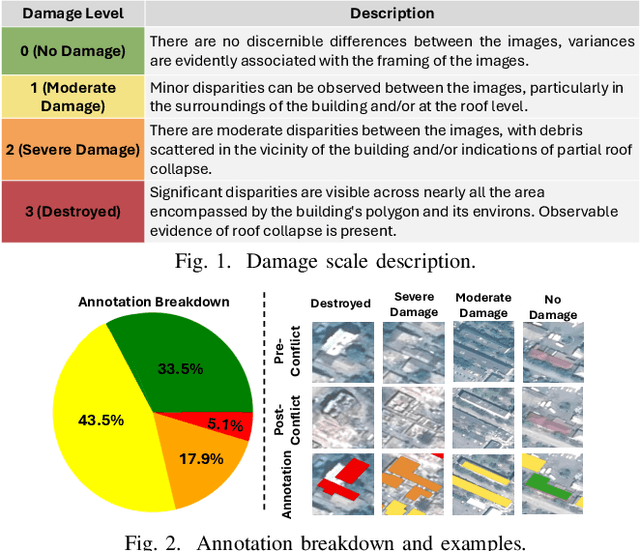

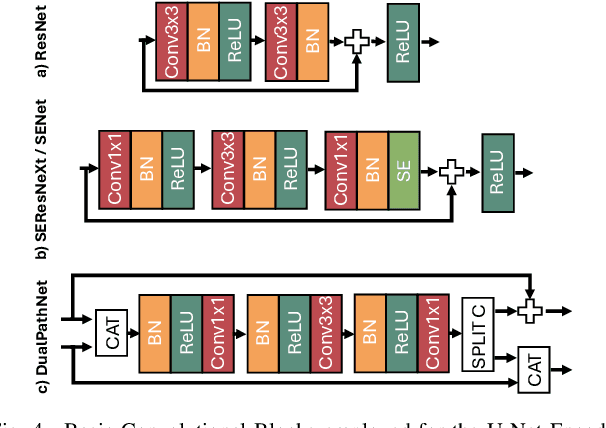
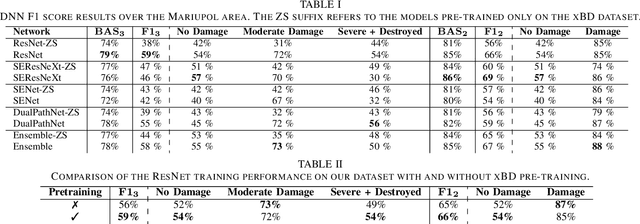
Abstract:Very High Resolution (VHR) geospatial image analysis is crucial for humanitarian assistance in both natural and anthropogenic crises, as it allows to rapidly identify the most critical areas that need support. Nonetheless, manually inspecting large areas is time-consuming and requires domain expertise. Thanks to their accuracy, generalization capabilities, and highly parallelizable workload, Deep Neural Networks (DNNs) provide an excellent way to automate this task. Nevertheless, there is a scarcity of VHR data pertaining to conflict situations, and consequently, of studies on the effectiveness of DNNs in those scenarios. Motivated by this, our work extensively studies the applicability of a collection of state-of-the-art Convolutional Neural Networks (CNNs) originally developed for natural disasters damage assessment in a war scenario. To this end, we build an annotated dataset with pre- and post-conflict images of the Ukrainian city of Mariupol. We then explore the transferability of the CNN models in both zero-shot and learning scenarios, demonstrating their potential and limitations. To the best of our knowledge, this is the first study to use sub-meter resolution imagery to assess building damage in combat zones.
Optimizing DNN Inference on Multi-Accelerator SoCs at Training-time
Sep 27, 2024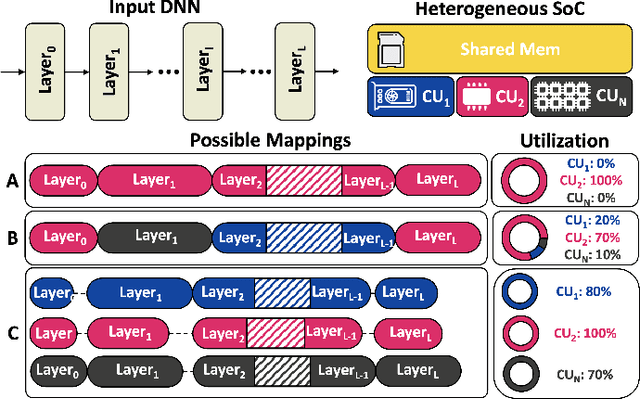
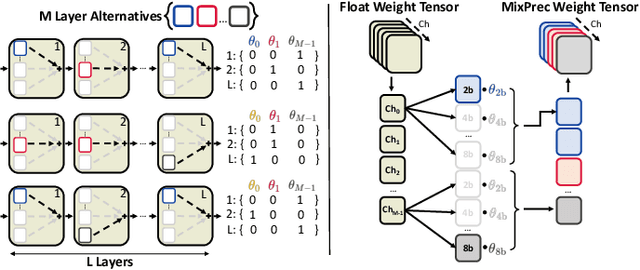
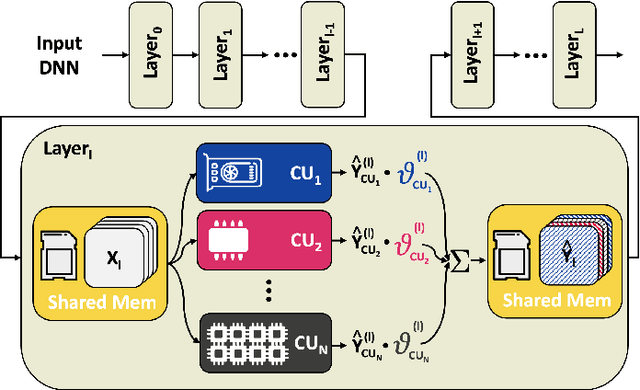

Abstract:The demand for executing Deep Neural Networks (DNNs) with low latency and minimal power consumption at the edge has led to the development of advanced heterogeneous Systems-on-Chips (SoCs) that incorporate multiple specialized computing units (CUs), such as accelerators. Offloading DNN computations to a specific CU from the available set often exposes accuracy vs efficiency trade-offs, due to differences in their supported operations (e.g., standard vs. depthwise convolution) or data representations (e.g., more/less aggressively quantized). A challenging yet unresolved issue is how to map a DNN onto these multi-CU systems to maximally exploit the parallelization possibilities while taking accuracy into account. To address this problem, we present ODiMO, a hardware-aware tool that efficiently explores fine-grain mapping of DNNs among various on-chip CUs, during the training phase. ODiMO strategically splits individual layers of the neural network and executes them in parallel on the multiple available CUs, aiming to balance the total inference energy consumption or latency with the resulting accuracy, impacted by the unique features of the different hardware units. We test our approach on CIFAR-10, CIFAR-100, and ImageNet, targeting two open-source heterogeneous SoCs, i.e., DIANA and Darkside. We obtain a rich collection of Pareto-optimal networks in the accuracy vs. energy or latency space. We show that ODiMO reduces the latency of a DNN executed on the Darkside SoC by up to 8x at iso-accuracy, compared to manual heuristic mappings. When targeting energy, on the same SoC, ODiMO produced up to 50.8x more efficient mappings, with minimal accuracy drop (< 0.3%).
Deeploy: Enabling Energy-Efficient Deployment of Small Language Models On Heterogeneous Microcontrollers
Aug 08, 2024



Abstract:With the rise of Embodied Foundation Models (EFMs), most notably Small Language Models (SLMs), adapting Transformers for edge applications has become a very active field of research. However, achieving end-to-end deployment of SLMs on microcontroller (MCU)-class chips without high-bandwidth off-chip main memory access is still an open challenge. In this paper, we demonstrate high-efficiency end-to-end SLM deployment on a multicore RISC-V (RV32) MCU augmented with ML instruction extensions and a hardware neural processing unit (NPU). To automate the exploration of the constrained, multi-dimensional memory vs. computation tradeoffs involved in aggressive SLM deployment on heterogeneous (multicore+NPU) resources, we introduce Deeploy, a novel Deep Neural Network (DNN) compiler, which generates highly-optimized C code requiring minimal runtime support. We demonstrate that Deeploy generates end-to-end code for executing SLMs, fully exploiting the RV32 cores' instruction extensions and the NPU: We achieve leading-edge energy and throughput of \SI{490}{\micro\joule \per Token}, at \SI{340}{Token \per \second} for an SLM trained on the TinyStories dataset, running for the first time on an MCU-class device without external memory.
Toward Attention-based TinyML: A Heterogeneous Accelerated Architecture and Automated Deployment Flow
Aug 05, 2024Abstract:One of the challenges for Tiny Machine Learning (tinyML) is keeping up with the evolution of Machine Learning models from Convolutional Neural Networks to Transformers. We address this by leveraging a heterogeneous architectural template coupling RISC-V processors with hardwired accelerators supported by an automated deployment flow. We demonstrate an Attention-based model in a tinyML power envelope with an octa-core cluster coupled with an accelerator for quantized Attention. Our deployment flow enables an end-to-end 8-bit MobileBERT, achieving leading-edge energy efficiency and throughput of 2960 GOp/J and 154 GOp/s at 32.5 Inf/s consuming 52.0 mW (0.65 V, 22 nm FD-SOI technology).
Joint Pruning and Channel-wise Mixed-Precision Quantization for Efficient Deep Neural Networks
Jul 01, 2024Abstract:The resource requirements of deep neural networks (DNNs) pose significant challenges to their deployment on edge devices. Common approaches to address this issue are pruning and mixed-precision quantization, which lead to latency and memory occupation improvements. These optimization techniques are usually applied independently. We propose a novel methodology to apply them jointly via a lightweight gradient-based search, and in a hardware-aware manner, greatly reducing the time required to generate Pareto-optimal DNNs in terms of accuracy versus cost (i.e., latency or memory). We test our approach on three edge-relevant benchmarks, namely CIFAR-10, Google Speech Commands, and Tiny ImageNet. When targeting the optimization of the memory footprint, we are able to achieve a size reduction of 47.50% and 69.54% at iso-accuracy with the baseline networks with all weights quantized at 8 and 2-bit, respectively. Our method surpasses a previous state-of-the-art approach with up to 56.17% size reduction at iso-accuracy. With respect to the sequential application of state-of-the-art pruning and mixed-precision optimizations, we obtain comparable or superior results, but with a significantly lowered training time. In addition, we show how well-tailored cost models can improve the cost versus accuracy trade-offs when targeting specific hardware for deployment.
BISeizuRe: BERT-Inspired Seizure Data Representation to Improve Epilepsy Monitoring
Jun 27, 2024



Abstract:This study presents a novel approach for EEG-based seizure detection leveraging a BERT-based model. The model, BENDR, undergoes a two-phase training process. Initially, it is pre-trained on the extensive Temple University Hospital EEG Corpus (TUEG), a 1.5 TB dataset comprising over 10,000 subjects, to extract common EEG data patterns. Subsequently, the model is fine-tuned on the CHB-MIT Scalp EEG Database, consisting of 664 EEG recordings from 24 pediatric patients, of which 198 contain seizure events. Key contributions include optimizing fine-tuning on the CHB-MIT dataset, where the impact of model architecture, pre-processing, and post-processing techniques are thoroughly examined to enhance sensitivity and reduce false positives per hour (FP/h). We also explored custom training strategies to ascertain the most effective setup. The model undergoes a novel second pre-training phase before subject-specific fine-tuning, enhancing its generalization capabilities. The optimized model demonstrates substantial performance enhancements, achieving as low as 0.23 FP/h, 2.5$\times$ lower than the baseline model, with a lower but still acceptable sensitivity rate, showcasing the effectiveness of applying a BERT-based approach on EEG-based seizure detection.
 Add to Chrome
Add to Chrome Add to Firefox
Add to Firefox Add to Edge
Add to Edge